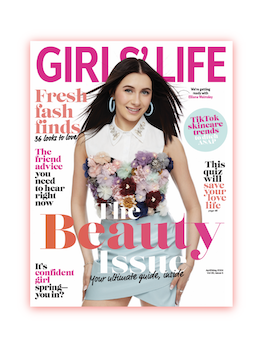LIFE
Get Inspired
Write a song in 5 easy steps
Songwriting can be a creative outlet for girls who love music. However, it can be a daunting task if you have never attempted to write a song before.
Whether you aspire to be the next Taylor Swift or are just looking for a way to express yourself, this guide will walk you through how to write a song in five easy steps even if you don't know much about music.
Start by writing a poem
I believe the easiest way to write a song if you are a beginner is to start by writing a poem.
You can write about whatever you want or about whatever's important to you. Let your imagination run wild and let the words flow.
There are really no rules in poetry or songwriting, so don't worry if your words don't rhyme or your poem doesn't follow the exact classification of a soliloquy, a haiku, or acrostic. Write from the heart and write until it sounds good to you.
Adapt your poem to fit the structure of a song
Songs are generally organized into five parts called verses, choruses, bridges, intros, and outros. Sometimes musicians may add parts called pre-choruses, hooks, musical eights, or breaks, but for the purpose of this beginner guide, we'll be focusing on the three most crucial parts. the verse, the chorus and the bridge.
The verse is the part of the song that tells the story. A typical song will have three verses that share the same melody but have differing lyrics in order to progress the narrative of the song.
The chorus is the "catchy" part of the song that repeats itself two or more times. I think of the chorus as the part I want people to remember when they're done listening.
The bridge is the wild card of the song. It sounds different from the verse and the chorus and has different lyrics as well. I always like to put my most hard-hitting lyrics in the bridge to wake listeners up toward the end of the song.
One of the most common ways to structure a song is as follows:
Verse One
Chorus
Verse Two
Chorus
Bridge
Chorus
Of course, there are many other ways to structure a song, but this is a good place to start. I've diagrammed Fearless by Taylor Swift to give you an example of this song structure in action.
Verse One
There's something 'bout the way
The street looks when it's just rained
There's a glow off the pavement
Walk me to the car
And you know I wanna ask you to dance right there
In the middle of the parking lot
Yeah
We're driving down the road, I wonder if you know
I'm trying so hard not to get caught up now
But you're so cool, run your hands through your hair
Absentmindedly making me want you
Chorus
And I don't know how it gets better than this
You take my hand and drag me head first, fearless
And I don't know why but with you I'd dance
In a storm in my dress, fearless
Verse Two
So, baby, drive slow 'til we run out of road in this one horse town
I want to stay right here, in this passenger's seat
You put your eyes on me
In this moment, capture it, remember it
Chorus
'Cause I don't know how it gets better than this
You take my hand and drag me head first, fearless
And I don't know why but with you'd I dance
In a storm in my best dress, fearless
Bridge
Well, you stood there with me in the doorway
My hands shake, I'm not usually this way but
You pull me in and I'm a little more brave
It's the first kiss, It's flawless, really something
It's fearless
Oh yeah
Chorus
'Cause I don't know it gets better than this
You take my hand and drag me head first, fearless
And I don't know why but with you I'd dance
In a storm in my best dress, fearless
Chorus
'Cause I don't know it gets better than this
You take my hand and drag me head first, fearless
And I don't know why but with you I'd dance
In a storm in my best dress, fearless
Outro
Oh, oh
Oh, yeah
As you can see, Fearless, *almost* follows the common structure I explained above however there are a few variations. There is an outro and Taylor repeats the chorus twice at the end instead of once. Additionally, the first verse is a little longer and a little different from the second.
I chose this example so that you can see how artists sometimes change and alter the typical structure of a song to create art that is more unique.
Don't ever feel like you need to write a song using a "formula". If you go deeper into music you'll see some people do this, by always using the exact same song structure, chord progressions, and by writing generic lyrics.
That said, the structure and tips I shared with you are typical for a reason: they create music that sounds good.
Now that you know how basic song structure words, it's time to adapt your poem to fit that structure.
Take a look at your poem and pick the most important stanza to become the chorus and the most unique part to become the bridge. The two stanzas that progress the narrative best should become verses.
At this point, you will probs need to do some re-writing. Chances are if you're a beginner songwriter you didn't originally write your poem with two clear and intentional verses, a catchy chorus, and a captivating bridge. That's totally fine. The poem is just meant to be a lyrical starting ground and a basis for the story of your song.
Choose a chord progression
A chord is a set of notes that creates harmony. A chord progression is a series of chords that sounds good to the ear.
The most common chord progression is something called the I-V-vi-IV progression. (aka the one-five-six-four progression). There is a lot of math, science, and theory behind why this progression is so satisfying to our ears and if you learn more about music theory later you'll learn what those numbers really mean. For now though, just remember that the I-V-vi-IV is the holy grail of pop chord progressions.
So what songs you this progression. Hmmm... let me see...there's...
- All Too Well by Taylor Swift
- Demons by Imagine Dragons
- Fight Song by Rachel Platten
- I'm Yours by Jason Mraz
- Out of the Woods by Taylor Swift
- Photograph by Ed Sheeran
- Someone You Loved by Lewis Capaldi
Just to name a few! The possibilities are endless with the four-chord progression.
So what chords can you use in the I-V-vi-IV progression. There's actually 24 possibilities depending on what key you want to write your song in. I'll list some of the most popular to give you a few possibilities for your first song.
Key of: I chord V chord vi chord IV
C C G Am F
D D A Bm G
A A E F# D
The next step is to sit down and write the chord progression into your song. I would highly recommend sitting down with a guitar or at a keyboard to this as it will make it a lot easier for you.
This is the part of the process that changes for me every time I write a song but generally, I'll just pick the first chord in my chosen progression hit on the guitar or piano and then I hum whatever feels right to me until the end of that first phrase of lyrics. Then, I hit the second chord in the progression and so on until I find a melody that feels right over top of the chord progression.
Writing a melody over the chords is not really a static process that can be explained. What I do is sing the lyrics in a bunch of different ways while strumming or playing the chords at the start or the ends of the lines. Eventually, I end up finding something that sounds good. I'm sure you will too if you keep trying!
Add an accompaniment and transitions
The final step of the songwriting process for me is writing an accompaniment that I can play along to my song and adding transtions to go between the verses, chorus, and bridge.
The easiest way to do this, if you don't have much musical knowledge, is to simply sturm or hit the chords to the tempo or rhythm of your song! You can get more complicated with it later, but if you're just writing a song for your own enjoyment this is an easy option to try.
As for transitions, you could write something complicated again if you know how or you could just strum a few beats in between each section if you feel it's needed. Sometimes though you can just go straight from one part of the song to another without using any real transition.
Record a demo
Whenever I finish writing a song for a friend, family member, or just for fun, I make sure to record a quick demo of it on my phone or computer so that later on I can come back and remember the song.
POSTED IN music, original songs

 become a contributor
become a contributor


















